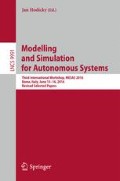Abstract
Affordances have been introduced in literature as action opportunities that objects offer, and used in robotics to semantically represent their interconnection. However, when considering an environment instead of an object, the problem becomes more complex due to the dynamism of its state. To tackle this issue, we introduce the concept of Spatio-Temporal Affordances (STA) and Spatio-Temporal Affordance Map (STAM). Using this formalism, we encode action semantics related to the environment to improve task execution capabilities of an autonomous robot. We experimentally validate our approach to support the execution of robot tasks by showing that affordances encode accurate semantics of the environment.
Access this chapter
Tax calculation will be finalised at checkout
Purchases are for personal use only
References
Chemero, A.: An outline of a theory of affordances. Ecol. Psychol. 15(2), 181–195 (2003)
Diego, G., Arras, T.K.O.: Please do not disturb! Minimum interference coverage for social robots. In: IEEE/RSJ International Conference on Intelligent Robots and Systems, pp. 1968–1973, September 2011
Epstein, S.L., Aroor, A., Evanusa, M., Sklar, E., Parsons, S.: Navigation with learned spatial affordances. In: COGSCI (2015)
Gibson, J.J.: The Ecological Approach to Visual Perception. Houghton Mifflin, Boston (1979)
Kim, D.I., Sukhatme, G.S.: Interactive affordance map building for a robotic task. In: 2015 IEEE/RSJ International Conference on Intelligent Robots and Systems (IROS), pp. 4581–4586. IEEE (2015)
Koppula, H.S., Gupta, R., Saxena, A.: Learning human activities and object affordances from RGB-D videos. The Int. J. Robot. Res. 32(8), 951–970 (2013)
Kunze, L., Burbridge, C., Hawes, N.: Bootstrapping probabilistic models of qualitative spatial relations for active visual object search. In: AAAI Spring Symposium on Qualitative Representations for Robots. Stanford University in Palo Alto, California, 24–26 March 2014
Lu, D.V., Hershberger, D., Smart, W.D.: Layered costmaps for context-sensitive navigation. In: IEEE/RSJ International Conference on Intelligent Robots and Systems, pp. 709–715, September 2014
Luber, M., Tipaldi, G.D., Arras, K.O.: Place-dependent people tracking. In: Pradalier, C., Siegwart, R., Hirzinger, G. (eds.) Robotics Research. STAR, vol. 70, pp. 557–572. Springer, Heidelberg (2011)
Montesano, L., Lopes, M., Bernardino, A., Santos-Victor, J.: Learning object affordances: from sensory-motor coordination to imitation. IEEE Trans. Robot. 24(1), 15–26 (2008)
Pandey, A.K., Alami, R.: Taskability graph: towards analyzing effort based agent-agent affordances. In: 2012 IEEE RO-MAN, pp. 791–796. IEEE (2012)
Rogers, J.G., Christensen, H.I.: Robot planning with a semantic map. In: 2013 IEEE International Conference on Robotics and Automation (ICRA), pp. 2239–2244, May 2013
Author information
Authors and Affiliations
Corresponding author
Editor information
Editors and Affiliations
Rights and permissions
Copyright information
© 2016 Springer International Publishing AG
About this paper
Cite this paper
Riccio, F., Capobianco, R., Hanheide, M., Nardi, D. (2016). STAM: A Framework for Spatio-Temporal Affordance Maps. In: Hodicky, J. (eds) Modelling and Simulation for Autonomous Systems. MESAS 2016. Lecture Notes in Computer Science(), vol 9991. Springer, Cham. https://doi.org/10.1007/978-3-319-47605-6_22
Download citation
DOI: https://doi.org/10.1007/978-3-319-47605-6_22
Published:
Publisher Name: Springer, Cham
Print ISBN: 978-3-319-47604-9
Online ISBN: 978-3-319-47605-6
eBook Packages: Computer ScienceComputer Science (R0)

